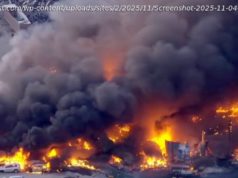A new state law has opened the artificial grass industry to what could be a big expansion.
From the front yards of West Miami-Dade to the waterfront mansions of Fort Lauderdale, artificial turf is appearing more and more.
And with the spread of artificial turf comes a mounting number of questions and criticisms — about everything from how it looks to how it impacts the environment, the climate and even human health. This stuff, made of plastic, can get absolutely skin scorching in the extreme heat of a South Florida summer.
But some homeowners still prefer it over natural, said Yoandy Perez, who has installed artificial turf at multiple homes in one East Hialeah neighborhood because they like that it looks neat year-round and saves on landscaping costs.
“The city doesn’t like concrete, but they want green,” said Perez. “Many places here are just sandy soil and construction fill. The clients prefer the turf.”
Now, a new state law has opened the multibillion-dollar artificial grass industry to what could be a big expansion, with lawmakers moving to forbid cities from banning fake grass in front yards. In Hialeah, turf is allowed with proper permits. But several South Florida cities and towns — including Coral Gables, Miami, Miami Lakes and Pembroke Pines — allow fake grass only out of sight in back or side yards.
But researchers and city governments say there are many downsides to expanding Florida’s fake grass footprint. Scientists warn that the synthetic plastic grass blades (beyond being made from petroleum) are not well suited for the warmer and wetter world the state is already experiencing from climate change. Artificial grass also can become extremely hot, doesn’t have the best drainage and isn’t easy to recycle.
Then there’s aesthetics of it. There have been years of fake vs. real disputes, including in Miami. When the real stuff along Brickell Avenue was ripped out and replaced with artificial, residents protested until the Miami officials agreed to remove the $230,160 project.
For now, despite the new law, the future of fake grass remains in a bit of a flux. This week, the Florida Department of Environmental Protection, or DEP, started accepting public comments and working on rule-making for turf on residential properties. Coral Gables and Miami Lakes officials told the Herald they are holding off changes to their permitting process until the state releases those standards.
“Once released, the Town will compare the State’s standards with the existing Town ordinance,” said Daniel Angel, Miami Lakes’ zoning director.
In sun-drenched places like Miami, where extreme heat warnings are common, you can often feel the difference between fake and real. Natural grass tends to cool thing off. And that’s not just what you or your dog might feel under your feet.
Домой
United States
USA — Science Fake grass is greener but is it worse for the environment? Florida...






